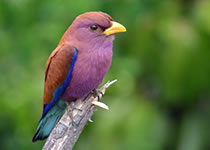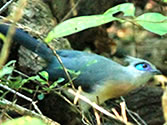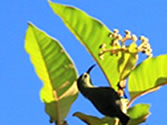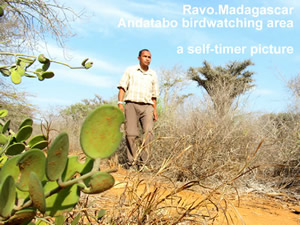Madagascar : the Tsingy, Nosy Be area, Baobab
For Birdwatching passionate people from Sept till December
 |
|
|
|
|
|
Birdwatching wildlife
in Madagascar
God loved the birds and invented trees and forests
Man loved the birds and invented cages !!!
[ Jacques Deval ] |
|
|
|
|
|

|
Since a few years, Madagascar has become a privileged destination in ecotourism and wildlife. Madagascar, an enchanting island, an authentic country, which will please you for its diversity and for its welcoming people. Madagascar, one of the best destination in the world for Birdwatching tour lovers and for trekking and hiking tour lovers. Madagascar, a destination off the beaten tracks.
Through tectonic movement, Madagascar has a long separation from neighboring continents, it split from Africa about 160 million years ago, from Antarctica about 120 million years ago and from India around 90 million years ago ; because of this separation, it contains many endemic species. Of the 293 bird species recorded on Madagascar, about 110 are found nowhere else on earth.
In October 2019 I've been with Birdwatching people from Canada
and we've seen more than 100 bird species in 16 days-trip ; 51 bird species of them were endemic to Madagascar.
We have seen THE Cryptic Warbler, Madagascar Brush Warbler, Rand's Warbler & Thamnornis Warbler, Velvet Asity, Crossley's Babbler, Pitta-like Ground-roller & Long-tailed Ground-roller ( in Ifaty ), Subdesert Mesite ( always in Ifaty ), Long-billed Greenbul, Appert's Greenbul & Spectacled Greenbul, Pollen's Vanga, Chabert's Vanga, Lafresnaye's Vanga & Sickle-billed Vanga ( in Ifaty for the three last ones ), a lot of Madagascar Magpie-Robin, Nelicourvi Weaver, different Coua species such as Crested Coua, Giant Coua and Running Coua, Madagascar Bush Lark, Common Jery, Green Jery and Stripe-throated Jery, Madagascar Harrier-Hawk, a lot of Souimanga Sunbird, etc.
With my experiences since ... 1993, you will be satisfied. I'm pleased to organise your trip and to guide you to make your trip pleasing and unforgetable. No one who visits the island is left unaffected either by the warmth and hospitality of the Malagasy people and its nature.
Because of lack of infrastructures in tourism in Madagascar ( number of good rooms, good vehicles, flights, etc. ) it's better to book your trip as soon as possible such as one year before your arrival.
  ![... it arrives and it goes [ Chinese proverb ] Madagascar Birding Tour, Madagascar Birdwatching, birdwatching wildlife in Madagascar](../madagascar_ravo_fbrut/Ravo_Madagascar_Bird_13.jpg)
Madagascar Birding Tour through THE BEST places for that
For birdwatching passionate people ; from September till December
| |
|
|
|
|
|
|
|
|
|
|
ITINERARY DETAILS :
This Birdwatching-16-days-tour is just an example and an idea of what you can do in Madagascar ; it can be customized for your number of people and for your number of days ( from 4 days till 18 days tour ). The accomodation is not included in the price, you can choose your hotels ; note that I can help you for that ( for advice and to book them ).
Through 8 very interesting birdwatching sites :
Andasibe and Mantadia humid evergreen forests, Iaroka ( need good physical condition ), Ranomafana and Zombitse National Parks (NP), Kirindy dry forest, Ifaty spiny forest and the southern Madagascar euphorbia scrub. Looking forward your coming soon with great pleasure. Thank you for your contact.
D1: Arrival in Tana
D2: Tana - Andasibe NP
D3: Mantadia NP
D4: Iaroka
D5: Andasibe - Antsirabe
D6: Antsirabe - Kirindy
With nocturnal visit of Kirindy forest for nocturnal lemurs
D7: Kirindy
a.m. Birds, nocturnal walk to try to see fosa
D8: Kirindy - Antsirabe
D9: Antsirabe - Ranomafana
D10: Ranomafana NP
D11: Ranomafana - Sakaraha
D12: Sakaraha - Ifaty
With Birds at Zombitse NP
D13: Ifaty spiny forest
D14: The southern Madagascar euphorbia scrub, then drive back to Tana
D15: Ambalavao - Tana
D16: Transfer to Tana ( Antananarivo ) airport
Price : 4050 Euros for 2 Persons, hotels & meals & your international flights not included |

Running Coua
Ravo.Madagascar 2013 ©

Long-tailed Ground-roller
Ravo.Madagascar 2013 ©

Subdesert Mesite
Ravo.Madagascar 2013 ©

Stripe-throated Jery
Ravo.Madagascar 2013 ©
|
|
|
|
|
|
|

West part of Madagascar
Pierrette ( September 2006 ) ©
I have worked in tourism in my country since ... 1993 till now as tour guide. So ... a lot of experiences ;-)
I love my country, Madagascar. I love public relations.
I love nature. I love people. I love trips.
These passions are what makes me good at my job. Thomas Peters said: « Success at work depends on passion ». I have passionate interest in tourism. And it's a pleasure for me to invite you to visit my wonderful country : Madagascar thank you.
For more details thank you to contact me at :

|
For the Birdwatching wildlife passionate people :
Quantitatively the bird found in Madagascar is not as rich as those in other countries, but the difference is in its endemicity ( about 110 species ). The most favorable period for observation goes from october to december.
Where are the best sites to observe birds in Madagascar ?
The easiest because of infrastructure facilities are ANDASIBE PERINET - MANTADIA National Parks and RANOMAFANA National Park. The both occur on montane rainforest and on mid-altitude rainforest. You can see there for examples : the Cryptic Warbler, Rufous-headed Ground-roller, Grey-crowned Greenbul, Brown Emutail, etc.
Some Madagascar National Parks to see Endemic birds :
It's easy too to find them at IFATY, AMPIJOROA - ANKARAFANTSIKA, ZOMBITSE and ANDOHAHELA National Parks which occur on southern or western deciduous dry forest. Sometimes it's a spiny forest ( characterised by the cactus-like trees and the Didierea trees ). And sometimes, it's a fairly dense seasonally dry forest where it's difficult to penetrate. You can see there for examples : the Thamnornis Warbler, Subdesert Brush-Warbler, Subdesert Mesite, Verreaux's Coua, Running Coua, Lafresnaye's Vanga, Red-shouldered Vanga, Littoral Rock Thrush, etc. Or the Red-capped and Giant Couas, Coquerel's Coua, Sakalava Weaver, Appert's Greenbul, White-breasted Mesite, Sickle-billed Vanga, Van Dam's Vanga, etc.
 
Broad-billed Roller & Madagascar Hoopoe
Tsingy of Bemaraha NP & Kirindy
 
Rufous Vanga & White-browed Owl ©
at Zombitse National Park - 2019
below are the calls of the birds above
Broad-billed Roller calls
|
|
|
|
Testimony
in Ankarafantsika and Andasibe-Mantadia National Parks
October 2014 with a couple of American tourists who were not really Birdwatching passionate people but who loved nature, who loved lemurs and who loved birds. Together we have seen just in three days ... 40 different species of Birds ; 17 species of them were Endemic to Madagascar. I give you as testimony the list of Birds that we have seen :
List of Birds species seen in Ankarafantsika National Park in October 2014 :
Those endemic to Madagascar :
Grey headed Lovebird • Long billed Greenbul • Crested Coua • Rufous Vanga • White-breasted Mesite • Schlegel's Asity • Magpie Robin • Madagascar Hoopoe • Madagascar lesser Cuckoo • Madagascar red Fody • Sakalava Weaver
Those not endemic to Madagascar :
Cuckoo Roller • Madagascar Paradise Flycatcher • Broad billed Roller • Madagascar Bee Eater • Yellow billed Kite • Pied Crow • Madagascar Coucal • Souimanga Sunbird • Dimorphic Egret • Cattle Egret • Great Egret • Purple Heron • Green-backed Heron • Squacco Heron
List of Birds species seen in Andasibe-Mantadia National Park, October 2014 :
Those endemic to Madagascar :
Nelicourvi Weaver • Madagascar wood Rail • Blue Coua • Madagascar Mannikin • Madagascar Wagtail • Madagascar long eared Owl
Those not endemic to Madagascar :
Madagascar Bulbul • Madagascar white eye • Ashy Cuckoo shrike • Common Jery • Lesser Vasa Parrot • Common Stonechat • Long billed green Sunbird
|
|
|
|
Birds of Madagascar that
I've seen with my clients
 
 
Crested Coua (Coua cristata) - in rollover : Coquerel's Coua (Coua coquereli)
Purple Heron (Ardea purpurea) - in rollover : Glossy Ibis (Plegadis falcinellus)
Van Dam's Vanga (Xenopirostris damii) - Souimanga Sunbird (Nectarinia souimanga)
All these pictures were taken by Vasili Mladinov at Ankarafantsika Park 2016 ©
 
 
Madagascar Birdwatching at Ifaty Belalanda areas
Ravo.Madagascar pictures 2019 ©
Long-tailed Ground-roller calls
On the way to see these birds above ( at Ankarafantsika National Park ) you can admire for more than half an hour this typical and amazing waterfall ( typical and amazing because of its unique color : a bright red brick ) : the Betsiboka waterfall river on the national road number 4 ( RN 4 ).


Red-Tailed Tropicbirds (Phaeton rubricauda at left & at right)
are Ravo 2007 pictures
Just for examples let's comment the Birds of Madagascar pictures above :
1- Red-tailed Tropicbird - Phaeton rubricauda :
Tropicbirds are medium-sized seabirds ( 30-35 cm tail-streamers ) found primarily in tropical oceans ; they typically come ashore only to breed. They are predominantly white, with elongated central tail feathers. Red-tailed Tropicbird is an elegant white seabird. When hunting for the flying fish ( and occasional squid ) they feed on, they hover above the water, then plunge dive in after their prey. There are 03 species worldwide, all of which have been recorded in Madagascar. You can see Red-tailed Tropicbird at Nosy Ve islet near Anakao in the South coast of Madagascar ( Tropicbirds are Order of Pelecaniformes and Family of Phaethontidae ).
2- Crested Drongo - Dicrurus forficatus :
The Drongos are mostly black or dark grey in colour, sometimes with metallic tints. They have long forked tails. They have short legs and sit very upright whilst perched, like a shrike. They flycatch or take prey from the ground. There are 24 species worldwide and only 01 species which occurs in Madagascar, the Crested Drongo that you can find everywhere ( trees, forest, plantations and sparsely wooded terrain ). So Crested Drongo is common, widespread and easily seen at most sites.
3- Crested Coua - Coua cristata :
Endemic to Madagascar. Not globally threatened. Easiest to see in south and west such as in Ifaty during our tour in september 2013. The Crested Coua is a medium-sized and largely arboreal coua ( size : 40-44 cm ).
4- White-faced Whistling Duck - Dendrocygna viduata :
Family of Anatidae. This family includes ducks and most duck-like waterfowl, such as geese and swans. These are birds that are modified for an aquatic existence with webbed feet, flattened bills and feathers that are excellent at shedding water due to an oily coating. There are 131 species worldwide and 10 species which occur in Madagascar ( Ducks are Order of Anseriformes and Family of Anatidae ). White-faced Whistling Duck occurs in sub-Saharan Africa and Central and South America. In Madagascar, common in the west ( such as Manambolo and Tsiribihina rivers where I go sometimes ). So White-faced Whistling Duck is common in most wetlands in Madagascar and easily seen at Lake Alarobia ( Antananarivo ).
5- Madagascar Hoopoe - Upupa marginata ( picture below ) :
Hoopoes have black, white and orangey-pink colouring with a large erectile crest on their head. There are 2 species worldwide, one of which occurs in Madagascar ( Hoopoes are Order of Coraciiformes and Family of Upupidae ). So Madagascar Hoopoe is endemic to Madagascar. Not globally threatened. Common in the north, west and south of Madagascar. Madagascar Hoopoe is easily to seen in the drier habitats such as in Anjà forest and Ifaty scrub during our birdwatching tour in 2013.
|
|
|
|

You have to organize in advance an adventure trip.
It depends on professionalism,
on experiences & on passion

Madagascar 16 Days Trip
for Birdwatching Passionate People
Only for October, November and December
Madagascar, quantitatively the bird found is not as rich as those in other countries ( just arround 285 bird species ). But the difference is in its endemicity ( 110 / 285 ). Come here to observe them with professional birdwatching local guides from October to December. Through 9 very interesting birdwatching sites : Andasibe-Analamazaotra, Mantadia, Ranomafana and Zombitse National Parks (NP), Kirindy forest, Ifaty spiny forest and the southern Madagascar euphorbia scrub on hillsides, then Ampijoroa forest station with Amboromalandy lake.
During my tour with Birdwatching people from Holland in October 2018 we've seen with Maurice 50 bird species in just two days-trip at Andasibe NP and at Mantadia NP ; more than 6 bird species of them were very difficult to see.
We've seen in just two days-trip THE Madagascar Wood Rail, White-throated Rail, Madagascar Flufftail, Pitta-like Ground-roller, Madagascar Crested Ibis, Velvet Asity, Blue Vanga, Chabert's Vanga, Red-tailed Vanga, Nuthatch Vanga, Tylas Vanga, Madagascar Long-eared Owl, Madagascar eastern rainforest Scops Owl, Barn Owl, Madagascar Bulbul, Madagascar Tetràkà or Long-billed Greenbul, Spectacled Greenbul, Madagascar Buzzard, Blue Coua, Madagascar Cisticola, Madagascar Cuckoo ex Madagascar Lesser Cuckoo, Cuckoo-Roller, Ashy Cuckoo-shrike, Madagascar Turtle Dove, Madagascar Green Pigeon, Meller's Duck, Madagascar Little Grebe, Common Moorhen, Purple Heron, Red-billed Teal, Nelicourvi Weaver, Madagascar White-eye, Madagascar Mannikin, Common Jery, White-throated Oxylabes, Madagascar Starling, Madagascar Long-billed Green Sunbird, Souimanga Sunbird, Swift Madagascar spiny-tail, Madagascar Swamp Warbler, Madagascar Brush Warbler, Crested Drongo, Madagascar Coucal, Madagascar Paradise Flycatcher, Madagascar Pygmy Kingfisher, Madagascar Malachite Kingfisher, Madagascar Magpie-Robin, Forest Fody, Madagascar red Fody, Greater Vasa Parrot
The name of my client during this very short Tour is : Mrs Ingeborg van Leeuwen and the link of its excellent web site is :
https://www.flickr.com/photos/ivl_wildlife_photography/sets/72157672975632657/
https://www.flickr.com/photos/ivl_wildlife_photography/

Madagascar Pygmy Kingfisher ©
in rollover : Madagascar Paradise Flycatcher ©
|
|
|
|
|
|
TO BRING ALONG WITH YOU :
Anti-mosquito spray and cream, pocket torch and spare batteries, head torch if possible, swimsuits, light clothes, but also some warm clothes for the highlands, cameras, small good padlocks for your luggage ; your personal medicines such as general antibiotics, anti-diarrhoea, antiseptics, e,g, Betadine, compresses and cotton, ointment for sprains, lip cream or gel ; protect yourself against malaria, e.g. follow a treatment. Sun cream ; sun glasses, walking shoes or closed sports shoes, plastic sandals to walk through streams, binoculars, swiss knife, k-way or windcheater, hat or cap AND cash money = Euros.
|

Most of evergreen rainforests in Madagascar are found on the east coast. This area is a must for naturalist where they can find the greatest diversity of the island's unique flora and fauna, magnificent rugged mountain scenery with rivers flowing down to the Indian Ocean, abundant seafood and fruit. December to March are the wettest months.
The east coast is the richest agricultural region of Madagascar, providing high quality produce for export such as tropical vanilla plant, coffee, etc. In the northeast, the Masoala Peninsula is a very rich ecosystem. You can found lying side by side, one of the largest remaining tracts of lowland virgin rainforest plunges almost vertically into the sea to meet a pristine coral reef. Masoala National Park has a great deal to offer naturalists. But it is the rainiest place in Madagascar.

Masoala Park, wonderful beach - Ravo 2007 ©
Ambanizana river - Y. Blanchard 2006 ©
Masoala's pristine rainforest, Masoala National Park, Madagascar :
Created in 1997, Masoala National Park is the largest protected forest in Madagascar. Conservationists and scientists praise the park as the last stronghold and refuge for many species facing increasing threats from slash-and-burn farming and logging practices. The park contains significant portions of lowland and coastal rainforest from sea level to 1200 m, covering about 230 000 ha. It is located in the northeast region of Madagascar, bordering the Bay of Antongil and the Indian Ocean.
There are hiking trails that skirt the entire peninsula, stretching from Maroantsetra to Mahavelona and all the way down to Cap Masoala via Tampolo Marine Park. From here, it continues along the coast past Ifaho Marine Park, then upwards towards Cap East and further along to the town of Antalaha. The main trails for visitors are at Tampolo / Ambodiforaha, Cap East and a multi-day hike is possible across the peninsula from Maroantsetra to Cap East ( 5-8 days ). You need porters and cook for this big trekking. Porters, cook and guide are available in Maroantsetra.
The waters around the peninsula is rich in marine life and the bay is protected from strong winds. The pristine beaches are perfect for swimming and snorkelling ( take your equipment with you ).
|
|
|
|

Clients' Testimonies after their trips in Madagascar :
• Erik Segers (Belgium ) has written in « LinkedIn » :
If you want to discover Madagascar, Ravo is your man to organise your trip from A to Z. Thanks to his deep knowledge and boundless enthusiasm we had a truly first class visit of this wonderful island. Without a doubt, I do recommend, wholeheartedly.
• Another person has said, always in « LinkedIn » :
Ravo is a professional guide who knows well his trade. He’ll face any situation with mastery and good humour, without seeking personal gain. At the end of the journey he has become a friend and he really deserves to be known for everyone’s benefit ( Sylvain Lefèvre - France )

|
|
|
|
  
Madagascar, a wonderland for nature lovers
a personal message of the webmaster
Be sure that in hell :
- there is no love
- there is no beauty
- there is no hope
- there is just ... torment !!!
[ from the movie THE ENCOUNTER of David A.R. White ]
  
|
RATSIMBAZAFY Ravo Nomenjanahary
Copyright © 2000 Christian-thought
e-mail : r_ravo@hotmail.com
Tel. ++ 261 32 41 063 65

The Christian
Counter


Webspace Provider
|
|
|
|